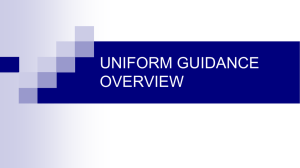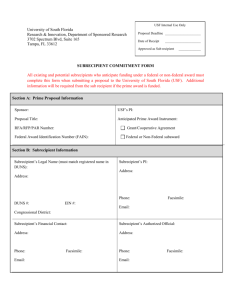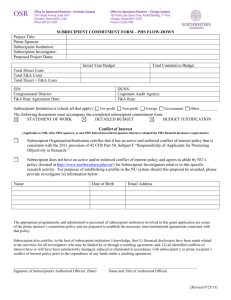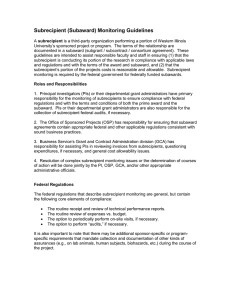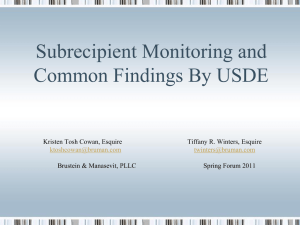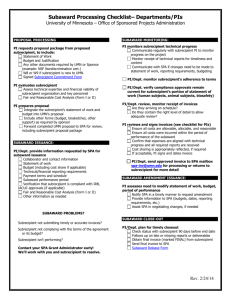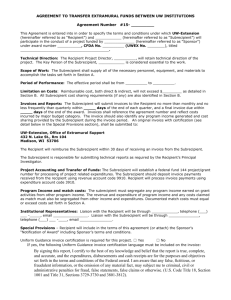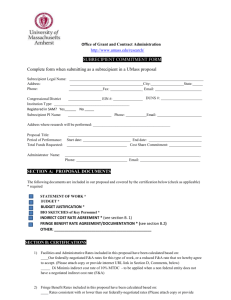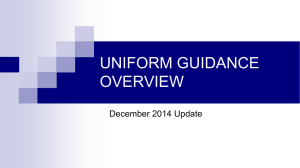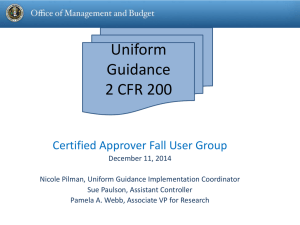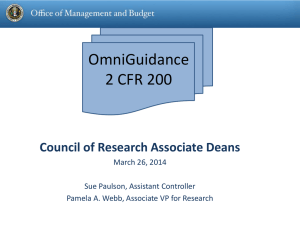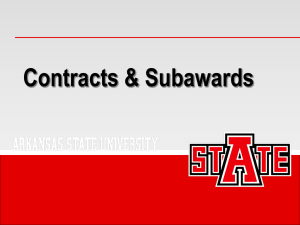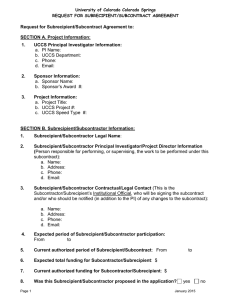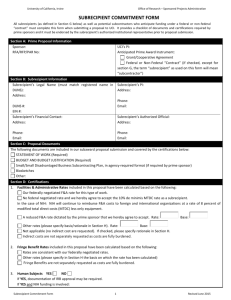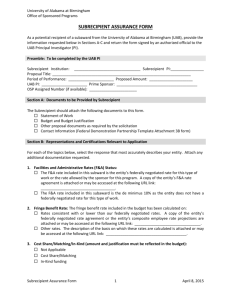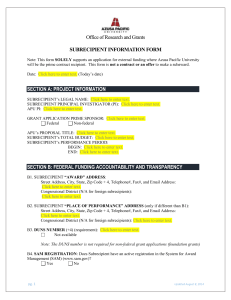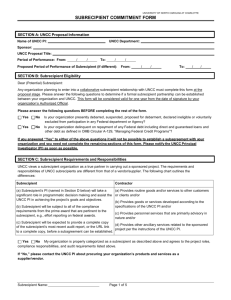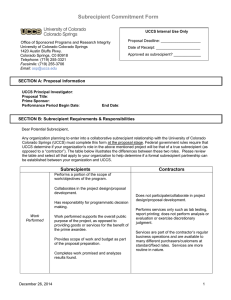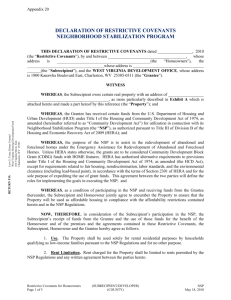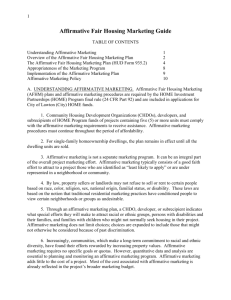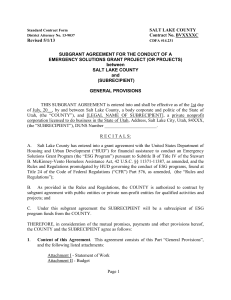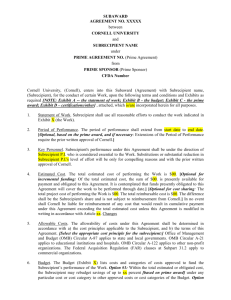Risk Assessment Questionnaire (RAQ)
advertisement
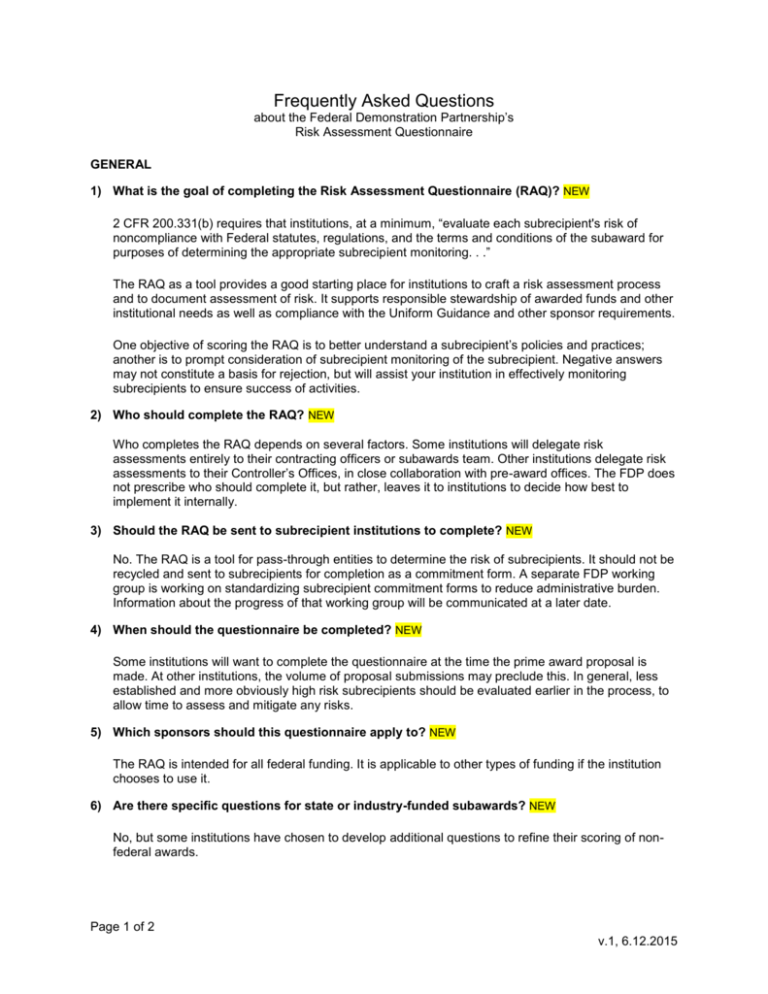
Frequently Asked Questions about the Federal Demonstration Partnership’s Risk Assessment Questionnaire GENERAL 1) What is the goal of completing the Risk Assessment Questionnaire (RAQ)? NEW 2 CFR 200.331(b) requires that institutions, at a minimum, “evaluate each subrecipient's risk of noncompliance with Federal statutes, regulations, and the terms and conditions of the subaward for purposes of determining the appropriate subrecipient monitoring. . .” The RAQ as a tool provides a good starting place for institutions to craft a risk assessment process and to document assessment of risk. It supports responsible stewardship of awarded funds and other institutional needs as well as compliance with the Uniform Guidance and other sponsor requirements. One objective of scoring the RAQ is to better understand a subrecipient’s policies and practices; another is to prompt consideration of subrecipient monitoring of the subrecipient. Negative answers may not constitute a basis for rejection, but will assist your institution in effectively monitoring subrecipients to ensure success of activities. 2) Who should complete the RAQ? NEW Who completes the RAQ depends on several factors. Some institutions will delegate risk assessments entirely to their contracting officers or subawards team. Other institutions delegate risk assessments to their Controller’s Offices, in close collaboration with pre-award offices. The FDP does not prescribe who should complete it, but rather, leaves it to institutions to decide how best to implement it internally. 3) Should the RAQ be sent to subrecipient institutions to complete? NEW No. The RAQ is a tool for pass-through entities to determine the risk of subrecipients. It should not be recycled and sent to subrecipients for completion as a commitment form. A separate FDP working group is working on standardizing subrecipient commitment forms to reduce administrative burden. Information about the progress of that working group will be communicated at a later date. 4) When should the questionnaire be completed? NEW Some institutions will want to complete the questionnaire at the time the prime award proposal is made. At other institutions, the volume of proposal submissions may preclude this. In general, less established and more obviously high risk subrecipients should be evaluated earlier in the process, to allow time to assess and mitigate any risks. 5) Which sponsors should this questionnaire apply to? NEW The RAQ is intended for all federal funding. It is applicable to other types of funding if the institution chooses to use it. 6) Are there specific questions for state or industry-funded subawards? NEW No, but some institutions have chosen to develop additional questions to refine their scoring of nonfederal awards. Page 1 of 2 v.1, 6.12.2015 7) What mechanisms are being used to track and collect answers? NEW In addition to subrecipient name, ID number, score, and risk category, one institution is tracking the following data on each subaward in an Excel workbook: a. Subrecipient entity type (College/University, Non-profit, University Affiliate, Foreign, Large Company, Small Company) b. Funding source (Federal, State, Local, Private) c. Prime sponsor d. Principal Investigator e. Research Unit The first three data elements are used to draw general conclusions about the sources of subrecipient risk. The last two data elements are used to calculate the average subrecipient risk level of the institution’s PIs and research units. PIs and research units with high risk subawards will be given additional training in subrecipient monitoring and risk mitigation. 8) How does the RAQ respond to the four examples of subrecipient risk factors listed in 2 CFR 200.331(6)(b)? NEW The four risks are: a. The subrecipient's prior experience with the same or similar subawards; b. The results of previous audits including whether or not the subrecipient receives a Single Audit in accordance with Subpart F—Audit Requirements of this part, and the extent to which the same or similar subaward has been audited as a major program; c. Whether the subrecipient has new personnel or new or substantially changed systems; and d. The extent and results of Federal awarding agency monitoring (e.g., if the subrecipient also receives Federal awards directly from a Federal awarding agency). The first factor is addressed by question 14. The second factor is addressed by questions 7 and 8. The third factor is addressed in part by questions 5 and 6. The fourth question is addressed by question 19. In general, question 15 can be used to address other risks not specifically listed elsewhere in the questionnaire. The risks cited as examples in the Uniform Guidance may be measured, but tend to be difficult to quantify. New personnel and substantially changed systems, for instance, may constitute a short-term risk, but may also produce a long-term reduction in risk when those new personnel and systems function better than those they replaced. Institutions may decide that certain answers given to scored or non-scored questions may prompt an additional set of questions outside of the RAQ, or a broader assessment of risk by means other than a questionnaire. 9) Why are certain risk factors addressed in both the scored and non-scored questions? For instance, questions 4 and 21 both address conflict of interest, and questions 7 and 19 both address audits. NEW The questions differ in the degree of risk being measured. A ‘no’ to question 4 is a stronger statement than a ‘no’ to question 21. Question 4 refers to a prime sponsor requirement for a conflict of interest policy, and question 21 does not. The risk implied by this question is therefore greater. Similarly, a ‘no’ to question 7 is a stronger statement than a ‘no’ to question 19. Question 7 indicates that an audit is required but has not been performed, and that the subrecipient is non-compliant. Question 19 does not specify that the audit is required. Page 2 of 2 v.1, 6.12.2015
